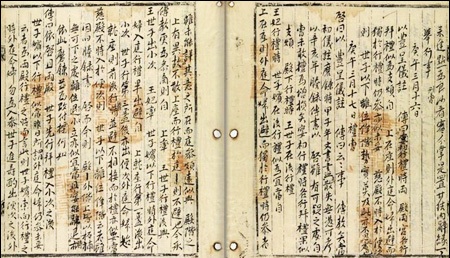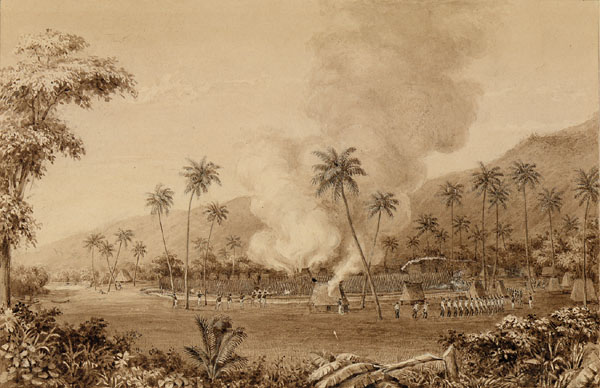|
Ganghwa Island
Ganghwa Island (Hangul ; Hanja ), also known by its native name Ganghwado, is a South Korean island in the estuary of the Han River. It is in the Yellow Sea, off Korea's west coast. The island is separated from Gimpo (on the South Korean mainland) by a narrow channel spanned by two bridges, and from Kaesong (Gaeseong) in North Korea by the main channel of the Han River. North Korea can be seen on clear days from less than two kilometers away on South Korea's Ganghwa Island allowing better views of North Korean villages than from elsewhere in South Korea. It is strategically located, controlling access to the river which runs through former Joseon and the present South Korean capital Seoul. Its fortifications were repeatedly attacked during the 19th century. With an area of , it constitutes most of Ganghwa County (a division of Incheon). The island has a population of about 65,500, half of whom live in Ganghwa Town (Ganghwa-eup) in the northeast. Name "Ganghwado" or "Ganghwa ... [...More Info...] [...Related Items...] OR: [Wikipedia] [Google] [Baidu] |
Hangul
The Korean alphabet, known as Hangul, . Hangul may also be written as following South Korea's standard Romanization. ( ) in South Korea and Chosŏn'gŭl in North Korea, is the modern official writing system for the Korean language. The letters for the five basic consonants reflect the shape of the speech organs used to pronounce them, and they are systematically modified to indicate phonetic features; similarly, the vowel letters are systematically modified for related sounds, making Hangul a featural writing system. It has been described as a syllabic alphabet as it combines the features of alphabetic and syllabic writing systems, although it is not necessarily an abugida. Hangul was created in 1443 CE by King Sejong the Great in an attempt to increase literacy by serving as a complement (or alternative) to the logographic Sino-Korean ''Hanja'', which had been used by Koreans as its primary script to write the Korean language since as early as the Gojoseon period (spanni ... [...More Info...] [...Related Items...] OR: [Wikipedia] [Google] [Baidu] |
Silt
Silt is granular material of a size between sand and clay and composed mostly of broken grains of quartz. Silt may occur as a soil (often mixed with sand or clay) or as sediment mixed in suspension with water. Silt usually has a floury feel when dry, and lacks plasticity when wet. Silt also can be felt by the tongue as granular when placed on the front teeth (even when mixed with clay particles). Silt is a common material, making up 45% of average modern mud. It is found in many river deltas and as wind-deposited accumulations, particularly in central Asia, north China, and North America. It is produced in both very hot climates (through such processes as collisions of quartz grains in dust storms) and very cold climates (through such processes as glacial grinding of quartz grains.) Loess is soil rich in silt which makes up some of the most fertile agricultural land on Earth. However, silt is very vulnerable to erosion, and it has poor mechanical properties, making construction ... [...More Info...] [...Related Items...] OR: [Wikipedia] [Google] [Baidu] |
Battle Of Ganghwa
The Battle of Ganghwa was fought during the conflict between Joseon and the United States in 1871. In May, an expedition of five Asiatic Squadron warships set sail from Japan to Korea in order to establish trade relations, ensure the safety of shipwrecked sailors, and to find out what happened to the crew of the SS ''General Sherman''. When American forces arrived in Korea, the originally peaceful mission turned into a battle when guns from a Korean fort suddenly opened fire on the Americans. The battle to capture Ganghwa Island's forts was the largest engagement of the conflict. Background The United States Navy expedition involved over 1,400 personnel, 542 sailors, 109 marines and six 12-pounder howitzers made up the landing party. Frigate USS ''Colorado'', the sloops USS ''Alaska'' and USS ''Benicia'' and the gunboats USS ''Monocacy'', and USS ''Palos'' were assigned to the operation, all together mounting 85 guns under the command of Rear Admiral John Rodgers and Comm ... [...More Info...] [...Related Items...] OR: [Wikipedia] [Google] [Baidu] |
United States Expedition To Korea
The United States expedition to Korea, known in Korea as the ''Shinmiyangyo'' () or simply the Korean Expedition, was the first American military action in Korea and took place predominantly on and around Ganghwa Island in 1871. The reason for the presence of the American land and naval force in Korea was to support an American diplomatic delegation sent to negotiate trade and political relations with the peninsular nation led by the American ambassador to China, Frederick Low, to ascertain the fate of the merchant ship ''General Sherman'', which had gone missing while visiting Korea in 1866. However, according to a ''National Interest'' article, Low's own records indicated the punitive campaign was motivated by a need to demonstrate American power over what he considered to be a weaker nation. Previously, the American commanders had felt entitled to be able to "peacefully" enter Korean waters for survey and trade using heavily armed warships and had ignored repeated diplomati ... [...More Info...] [...Related Items...] OR: [Wikipedia] [Google] [Baidu] |
Korean Buddhist Temples
Buddhist temples are an important part of the Korean landscape. This article gives a brief overview of Korean Buddhism, then describes some of the more important temples in Korea. Most Korean temples have names ending in ''-sa'' (사, 寺), which means "temple" in Sino-Korean. Many temples, like Sudeoksa, offer visitors a Temple Stay program. Background A distinctive form of Buddhism evolved in Korea. This was facilitated by the geographical location and cultural conditions. Buddhism first arrived in Korea in 372 in Goguryeo. In 374 the influential Han Chinese monk Ado arrived in the kingdom and inspired King Sosurim of Goguryeo the following year. The first two temples Seongmunsa and Ilbullansa were built in 375 on the order of the king. Buddhism soon became the national religion of Goguryeo. With the advent of Taoism in 624 the rulers began to suppress Buddhism and its importance quickly declined. The Baekje Kingdom, on the other hand, flourished under the influence of Budd ... [...More Info...] [...Related Items...] OR: [Wikipedia] [Google] [Baidu] |
Pierre-Gustave Roze
Pierre-Gustave Roze (28 November 1812 – November 1883) was a French admiral. He was born in Toulon, France, and throughout his adult life served as a career naval officer. As a young rear admiral (contre-amiral) he served in Mexico during the French intervention there of 1862. In 1865 he was appointed commander of the French Far Eastern Station (Station des mers de Chine). As commander, he was primarily stationed in Yokohama, headquarters of the French Far Eastern Squadron, though he was involved in naval operations in nearby Korea and French Indochina in 1866. He won most recognition during the French Campaign against Korea in 1866, an offensive involving the French Far Eastern Squadron as well as French marines that proved a failed attempt to force reparations from the Korean court for its persecution of French and native Catholics. After the Korean expedition Roze and his fleet returned to Japan, where they were able to welcome the first French military mission to Japan (1 ... [...More Info...] [...Related Items...] OR: [Wikipedia] [Google] [Baidu] |
French Expedition To Korea
The French expedition to Korea (french: Expédition française en Corée, ) was an 1866 punitive expedition undertaken by the Second French Empire against Joseon Korea in retaliation for the execution of seven French Catholic missionaries. The encounter over Ganghwa Island lasted nearly six weeks. The result was an eventual French retreat, and a check on French influence in the region. The encounter also confirmed Korea in its isolationism for another decade, until Japan forced it to open up to trade in 1876 through the Treaty of Ganghwa. In contemporary South Korea it is known as the ''Byeong-in yangyo'', or "Western disturbance of the ''byeong-in'' year". Background Throughout the history of the Joseon dynasty, Korea maintained a policy of strict isolationism from the outside world (with the exceptions being interaction with the Qing dynasty and occasional trading with Japan through the island of Tsushima). However, it did not succeed entirely in sealing itself off from ... [...More Info...] [...Related Items...] OR: [Wikipedia] [Google] [Baidu] |
Heungseon Daewongun
Heungseon Daewongun (흥선대원군, 興宣大院君, 21 December 1820 – 22 February 1898; ), also known as the Daewongun (대원군, 大院君), Guktaegong (국태공, 國太公, "The Great Archduke") or formally Internal King Heungseon Heonui (흥선헌의대원왕, 興宣獻懿大院王) and also known to contemporary western diplomats as Prince Gung, was the title of Yi Ha-eung, the regent of Joseon during the minority of Emperor Gojong in the 1860s and until his death a key political figure of late Joseon Korea. ''Daewongun'' literally translates as "prince of the great court", a title customarily granted to the father of the reigning monarch when that father did not reign himself (usually because his son had been adopted as heir of a relative who did reign). While there had been three other Daewonguns during the Joseon dynasty, there was no one as dominant as Yi Ha-eung in the history of the Joseon dynasty that the term Daewongun usually refers specifically to him. Gran ... [...More Info...] [...Related Items...] OR: [Wikipedia] [Google] [Baidu] |
Christianity In Korea
The practice of Christianity in Korea is marginal in North Korea, but significant in South Korea, where it revolves around two of its largest branches, Protestantism and Catholicism, accounting for 8.6 millionAccording to figures compiled by the South Korean National Statistical Office. and 5.8 million members, respectively. Catholicism was first introduced during the late Joseon Dynasty period by Confucian scholars who encountered it in China. In 1603, Yi Gwang-jeong, a Korean diplomat, returned from Beijing carrying several theological books written by Matteo Ricci, an Italian Jesuit missionary to China.KIM Han-sik, 'The Influence of Christianity', ''Korean Journal'' XXIII, 12, December 1983, p. 5. He began disseminating the information in the books, and the first seeds of Christianity were sown. In 1758, King Yeongjo of Joseon officially outlawed Catholicism as an "evil practice." Catholicism was reintroduced in 1785 by Yi Seung-hun and since then French and Chines ... [...More Info...] [...Related Items...] OR: [Wikipedia] [Google] [Baidu] |
Catholic Church In France
, native_name_lang = fr , image = 060806-France-Paris-Notre Dame.jpg , imagewidth = 200px , alt = , caption = Cathedral Notre-Dame de Paris , abbreviation = , type = National polity , main_classification = Catholic , orientation = Christianity , scripture = Bible , theology = Catholic theology , polity = , governance = CEF , structure = , leader_title = Pope , leader_name = , leader_title1 = President , leader_name1 = Éric de Moulins-Beaufort , leader_title2 = Primate of the Gauls , leader_name2 = Olivier de Germay , leader_title3 = Apostolic Nuncio , leader_name3 = Celestino Migliore , fellowships_type = , fellowships = , fellowships_type1 = , fellowships1 = , division_type = , division = , division_type1 = , divis ... [...More Info...] [...Related Items...] OR: [Wikipedia] [Google] [Baidu] |
Punitive Expedition
A punitive expedition is a military journey undertaken to punish a political entity or any group of people outside the borders of the punishing state or union. It is usually undertaken in response to perceived disobedient or morally wrong behavior by miscreants, as revenge or corrective action, or to apply strong diplomatic pressure without a formal declaration of war (e.g. surgical strike). In the 19th century, punitive expeditions were used more commonly as pretexts for colonial adventures that resulted in annexations, regime changes or changes in policies of the affected state to favour one or more colonial powers. Stowell (1921) provides the following definition: When the territorial sovereign is too weak or is unwilling to enforce respect for international law, a state which is wronged may find it necessary to invade the territory and to chastise the individuals who violate its rights and threaten its security. Historical examples *In the 5th century BC, the Achaemenid ... [...More Info...] [...Related Items...] OR: [Wikipedia] [Google] [Baidu] |
Korea Meteorological Administration
The Korea Meteorological Administration () (KMA) is the national meteorological service of the Republic of Korea. The service started in 1904 joining the WMO in 1956. Numerical Weather Prediction is performed using the Unified Model software suite. History The current Administration was established in 1990. Temporary observatories set up in 1904 in Busan, Incheon, Mokpo and elsewhere were precursors to the current KMA. The Central Meteorological Office (CMO) was established in August 1949. In April 1978, CMO was renamed the Korea Meteorological Service(KMS). In 1999, the Administration introduced a meteorological supercomputer for forecasting. As of November 2021, supercomputers ''Guru'' and ''Maru'' ranked 27th and 28th respectively in the world. In 2010, the KMA launched South Korea’s first geostationary meteorological satellite, the Communication, Ocean and Meteorological Satellite (COMS), also known as Chollian. Chollian started its official operation in 2011. The Seoul an ... [...More Info...] [...Related Items...] OR: [Wikipedia] [Google] [Baidu] |



.jpg)


